Congratulations on making it through another record-breaking Black Friday and Cyber Monday. These eye-opening numbers illustrate just how busy online retailers were from November 27-30:
- Shopify’s data shows that sales increased 76% on its platform during the Black Friday to Cyber Monday (BFCM) stretch in 2020 compared to 2019.
- Amazon posted a 60% increase in sales on its marketplace.
- Adobe estimates that $9 billion was spent online in the U.S. on Black Friday alone.
Yet as retailers will know from experience, the BFCM period has blurred into one long, festive shopping extravaganza.
Mastercard has coined the phrase “The 75 days of Christmas” to cover this extended run of increased online spending. It begins in October (this year’s Prime Day on October 13-14 is a handy marker) and continues until after Christmas Day.
In the broader context of 2020, there were some clear winners and losers over this year’s frenzied shopping period.
The winners adapted quickly to the COVID-19 economy. With brick-and-mortar stores closed, shoppers turned to ecommerce in unprecedented numbers this year.
While some of this initial boost is temporary, we are also witnessing a more permanent shift in shopper preferences. When the brick-and-mortar stores reopened, shoppers still wanted the convenience and safety of online delivery.
The growth of both the “Buy online, pickup in-store (BOPIS)” model and the advent of curbside pickup were two strong indicators of this change.
Retailers with the agility to offer these options – and the digital know-how to communicate this message through search and social – tapped into new audience demand.
Of course, this year’s losers were those that resisted the move to ecommerce and mcommerce as standard. The impact was felt most severely in U.S. states with restrictions on family gatherings.
Adobe reports that in states with the strictest restrictions, online shopping growth was 265% higher than in states with more lenient regulations.
Even in a period of enormous demand, just being online is not enough to qualify a retailer as a “winner.” Those who did not invest in their IT infrastructure struggled to process traffic surges, meaning missed sales opportunities.
There is still time to learn lessons from Black Friday data and make the most of Christmas – but retailers must act now across both ecommerce and mcommerce.
Ecommerce & Mcommerce: What’s the Difference?
First, we should briefly outline the similarities and differences between ecommerce and mcommerce.
- Ecommerce (electronic commerce) is the online purchase and sale of goods or services.
- Mcommerce (mobile commerce) is shopping online without a desktop device, usually through a smartphone.
Much of what we define as mcommerce falls under the broad umbrella term “ecommerce,” but the distinctions are important to draw out.
Mcommerce means increased convenience for consumers, who can shop from anywhere. It also means improved location tracking for retailers, along with the potential for in-app payments and innovative technologies such as augmented reality.
Although retailers should always consider ecommerce and mcommerce together, it’s essential to have a two-pronged strategy that caters to the unique strengths of each.
Let’s look first at some tips to make the most of ecommerce in your holiday marketing campaigns.
Ecommerce Trends & Tips for Holiday Marketing
Just how significant has the rise in ecommerce has been this year?
Consider some retail statistics from the first period of lockdown.
In April 2020, ecommerce websites in the U.S. processed more transactions on average every single day than they did on Black Friday 2019.
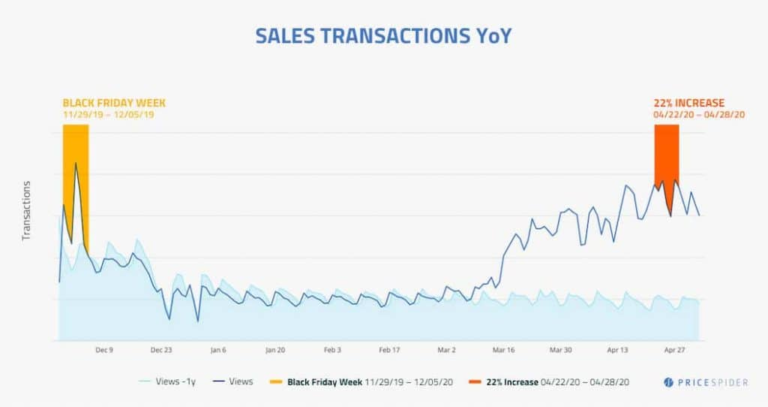
This is natural. Stores closed, and people shopped online instead.
But it also means that retailers have had to accustom themselves to this level of demand, leading to what will be a particularly busy Christmas.
Salesforce predicts that 30% of global holiday sales will take place online this year. Emarketer puts this figure at 35.8%:
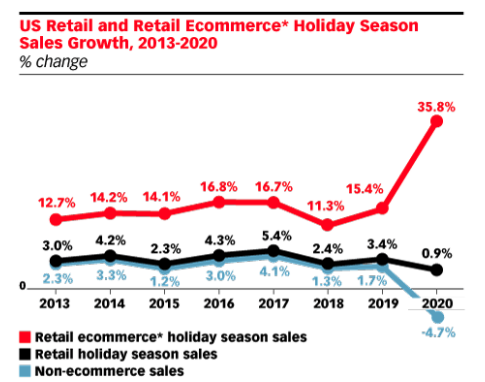
SEO & Content Tips for Ecommerce
Optimize the First-Time Customer Experience
Many customers will shop online for the first time this year. That will create a lot of opportunity for one-off sales, but sophisticated retailers will go the extra mile to convert these new customers into lifelong fans.
First, create a plan for content marketing and retargeting, so you can follow up with these customers in the future – for everything from cart abandonment to loyalty offers.
It’s important to keep in mind that research from BrightEdge (disclosure: I work for the company) showed people are buying more items when they shop online. Some items purchased may be smaller in value so ensure the experience you provide give options to buy more via discounts and maximize their visit time.
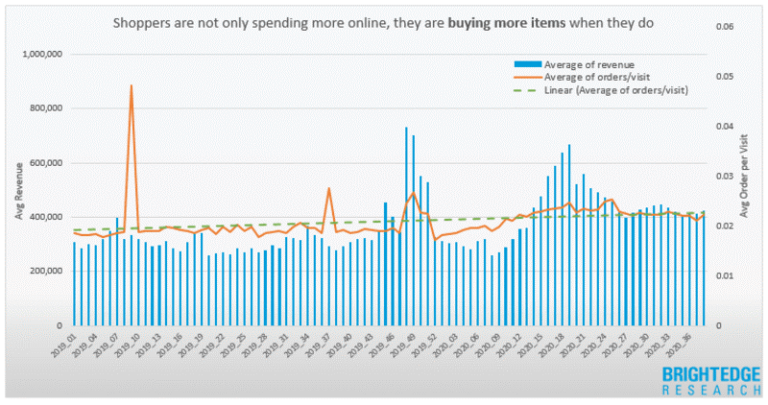 Utilize All Content Assets to Communicate Critical Messages
Utilize All Content Assets to Communicate Critical Messages
Shoppers want convenience and safety from their shopping experience this year. SEO and content marketing offer excellent opportunities to get your message across.
Consider creating new pages on your website to detail your approach to COVID-secure shopping, then use titles and descriptions on your ecommerce pages to highlight points of difference.
Focus on your brand’s authority to reassure customers and make your delivery and returns policies very clear.
Lean Into the Machine Learning Insights & Automation
Machine driven real-time insights, automation, and personalization on ecommerce stores are finally taking off, while voice commerce continues to rise.
You can use existing ecommerce technologies to add personalization to your website. (You don’t need to develop your own.)
At the same time, the development kits for Alexa Skills and Google Actions allow for quick deployment.
Seek out New Keyword Opportunities
In a typical year, retailers can update their long-standing festive product pages with the latest year and watch the traffic roll in.
This year, merely swapping out 2019 for 2020 is unlikely to match your audience’s search behaviors.
The early-mover advantage is enormous in SEO; research the latest keyword research trends in real-time to understand and model intent and include them in your content strategy before competition increases.
Mcommerce Trends & Tips
Mcommerce has become a significant shopping channel in its own right. Its rise will continue to accelerate worldwide as more people go mobile-first or mobile-only.
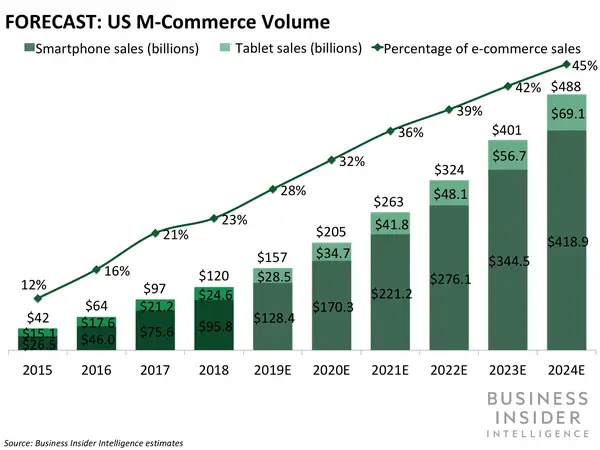
Over the holiday season, mcommerce is typically the primary beneficiary of Christmas Day shopping, with consumers reaching for their smartphones even while spending time with family.
Criteo finds that Christmas Day is actually the busiest day of the year for mcommerce:
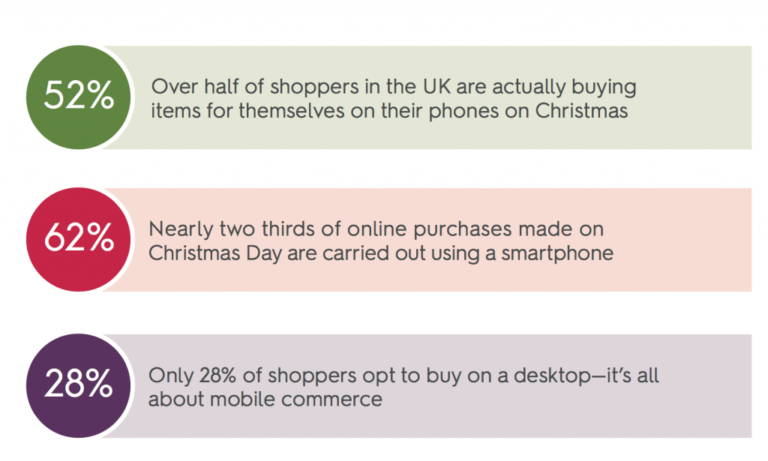
For retailers, mcommerce provides the opportunity to offer a lot more than just a small-screen version of the desktop site.
The user intent will be different on a mobile device, and the technology is available today to cater to these needs in real-time.
You can make use of everything from streamlined, in-app payments to augmented reality experiences, so there is no shortage of mcommerce options.
Retailers should instead stay close to their customers and provide the innovations that help them complete actions quickly and safely.
SEO & Content Tips for Mcommerce
Create Social-Friendly Content
Mcommerce and social commerce are closely linked, with the vast majority of social media purchases taking place on smartphones.
When you create content for your app or website, ensure that images and text can be shared on popular social networks.
You can sell directly on social channels, but you should also consider the persuasive potential of social media for increasing sales on your website.
Customers who find you through social media will expect a mobile-first experience across all of your platforms.
Focus on Speed
Conversion rates on mobile devices are increasing rapidly, but shoppers can be impatient when sites are slow to load.
Seek out quick wins to improve site speed, which Google may reward with improved SEO rankings.
Google PageSpeed Insights will provide some free tips to ensure your audience stays on your site to complete their purchases.
Think Local
The growth of “Buy online, pickup in-store (BOPIS)” creates an opportunity for mcommerce.
Look out for increases in “near me” searches in your product category, as this may suggest customers are keen to shop with retailers that have a local presence.
Update your Google My Business profile and ensure that your purchase and pickup offerings are highlighted across the website.
Simplify Your Online Store Architecture
Mobile shoppers require a site that is easy to navigate.
Retailers that started with a desktop shopping experience can often retain a complicated site architecture that is cumbersome when viewed on a smaller screen.
Try to keep all products within three clicks (or taps) from the homepage by reordering products and reviewing internal links.
You can also use editorial content to group collections together in a social media-friendly format.
Make sure you spot anything that is broken and implement quick fixes where you can.
Wrapping Up
The lessons from the Black Friday period are clear, and those who act now will reap the rewards.
Retailers are in the midst of the frantic festive period, but there is still time to make some all-important updates.
Although ecommerce and mcommerce are closely aligned, savvy retailers know that to take full advantage of their potential, they must implement a two-pronged strategy.
Following the tips above – using both search and business intelligence at your disposal – and aligning your SEO and PPC ecommerce programs will help prepare the ground for a prosperous Christmas period and a successful start to your new year.
More Resources:
- Ecommerce Product Page SEO: 20 Dos & Don’ts
- 11 Social Media Marketing Strategies for Ecommerce Websites
- Ecommerce Marketing: The Definitive Guide
Image Credits
All screenshots taken by author, December 2020





